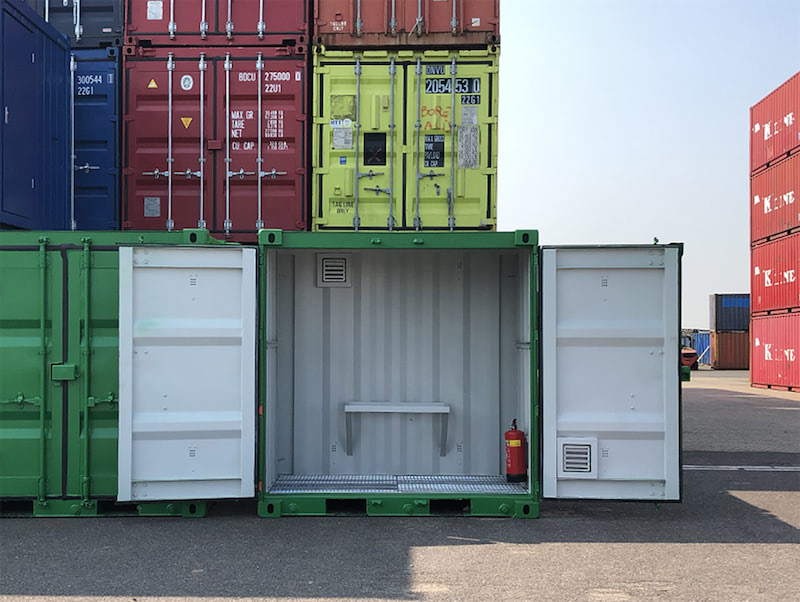In ports such as Rotterdam, you usually see large containers being loaded and unloaded onto ships. That’ s therefore the first thing most people think of when they hear the word ‘container’. But the term container covers much more.
Shipping containers
The large containers in the ports are shipping containers. Shipping containers can be used to transport or store both small and large goods. In terms of transport, the shipping container can be easily transported via ships, trucks and cargo trains.
The dimensions of a shipping container are indicated in feet (ft). A shipping container has standard sizes: 20ft and 40ft. There’s one size that differs from these in terms of height, the so-called 40ft ‘High cube’, usually abbreviated to 40ft HC. The 20ft shipping containers are regularly used for storage, but also for worldwide transport via ships, trains and trucks. Which container is best suited for transport (20ft or 40ft) depends on the quantity of goods to be transported. The maximum weight of a shipping container regardless of size is 30,480 kg.
In addition, there are often markings on the containers indicating, among other things, the dimensions and weight and the owner of the container.
To prevent shipping containers from shifting, there are stackers. There are also ‘twist locks’, with which the containers are actually secured. These twist locks are rotatable conical pins that fit precisely into the fastening points of the container. Containers can thus be secured to ships and stacked on top of each other.
Tank containers
Gases, liquids and powders are transported in tank containers.
The inside of the tank container is made of stainless steel, surrounded by a protection and insulation layer. The capacity of a tank container can vary from 14,000 to 27,000 litres. As with the shipping container, common dimensions are 20ft and 40ft.
Tank containers can also be divided into types. A silo tank, for example, is used for grains and powders and a reefer tank to keep the contents cool. There’s also a multi-compartment tank, with one or two partitions, allowing different types of goods to be stored in one tank.
Accomodation containers
Accomodation containers are often used as temporary living quarters or office space. These containers can be equipped with air conditioning, kitchen, shower and toilet.
Construction containers
Construction containers are used for transporting construction and demolition waste to the dump. Construction and demolition waste includes: plastic, plasterboard, wood, rubble, stone, metals and insulation material. This waste must be returned to the dump properly separated for recycling. It’s of course more practical to separate all the waste immediately, i.e. to fill the construction container with only one type of waste at a time.
A construction waste container can also have the dimensions of 3m3, 6m3, 10m3 and 15m3. Some of these are also lockable with padlocks.
Environmental containers
For the safe transport and storage of certain hazardous substances, it’s compulsory to use environmental containers. An environmental container often has a grid floor and drip tray to catch dangerous substances in the event of a leak. There are also usually ventilation grilles present and the environmental containers can be fitted with heavy duty locks. There are also fireproof environmental containers, environmental containers with cooling and environmental containers for liquids and gases with tank.

Swap body containers
A swap body container is easy to separate from the supporting vehicle. Often with attachment points for twist locks.
To transfer a swap body container from a lorry to a train (or vice versa of course), it must have grips on the underside so that it can be lifted. Sometimes there are also twist locks on the top, where the swap body container can be lifted.
Swap body containers are usually 2.50 or 2.55 metres wide. The length is divided into two classes: ‘A-Behalter’ and ‘C-Behalter’. A container in the A-Behalter class is 12 metres wide and longer, in the C-Behalter it is wider or longer than about 6 metres, but shorter than 12 metres.
There are four versions of the swap body container: the ‘classic’, the stackable C-Behalter, Swap body tanks and hook bodies.
- The classic version has a light construction, so it’s not stackable. It’s often used for transporting pallets.
- The stackable C-Behalter is, as the name suggests, stackable. Up to 6 containers of this type can be stacked.
- A swap body tank does not actually meet the requirements of a container. Hence the different name. A swap body tank is often longer than 20ft and wider than sea containers.
- Swap body containers are usually also seen as a variant of the swap body container, but are often not called that.
Reefer containers
Goods are kept cool in a reefer container. The term comes from refrigerator. The abbreviation for this ‘ref’ has been formed into ‘reefer’. There are two reefer containers: porthole containers and the integrated refrigerated container. With a porthole container, there’s no refrigeration unit. It must be connected via the 2 portholes (holes). With the integrated reefer containers, the cooling system is already present. The only thing you have to do is to set the temperature and plug it in.

Sources (mostly in Dutch):
- KC Trading
- Alconet (zeecontainer)
- Alconet (container termen)
- BIC
- Wikipedia (twistlocks)
- Wikipedia (tankcontainer)
- Wikipedia (wissellaadbak)
- Wikipedia (reefer)
- Holland Tank Service
- Bouwbakkie (bouw- en sloopafval)
- Bouwbakkie (containerverhuur)
- Hacon Containers
- G. Vernooy Containers BV

